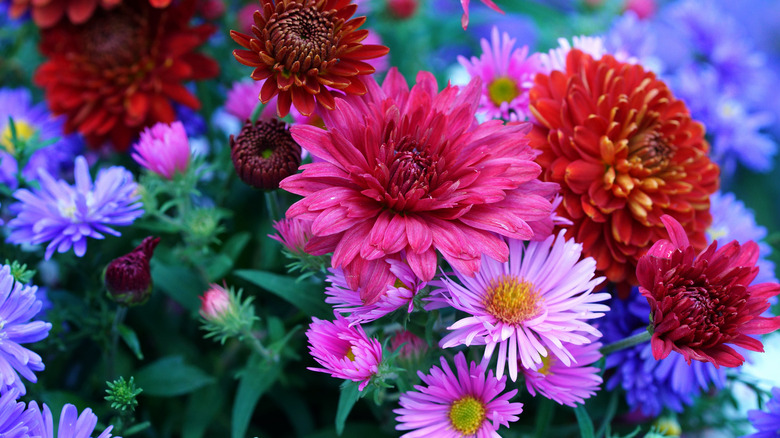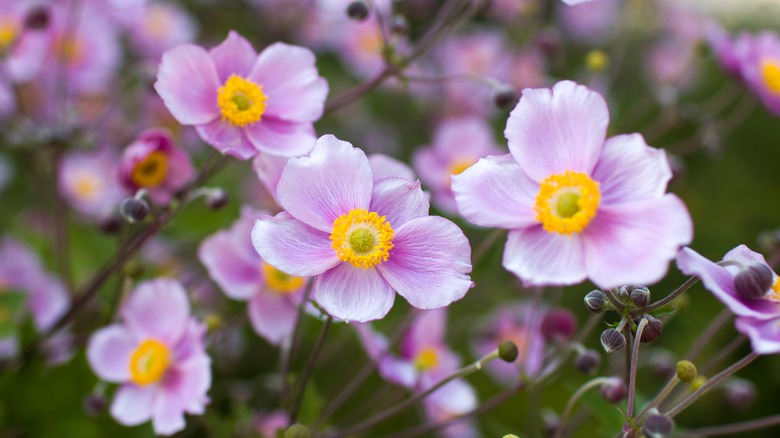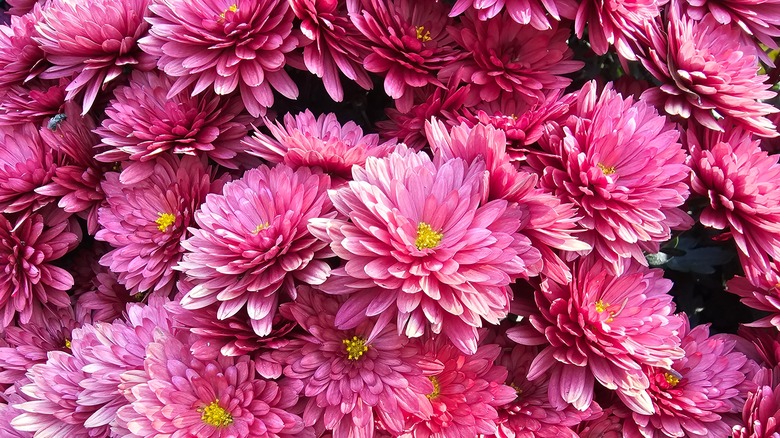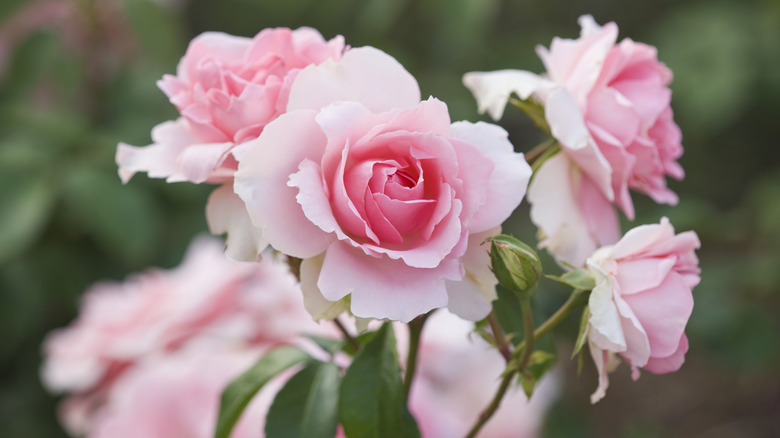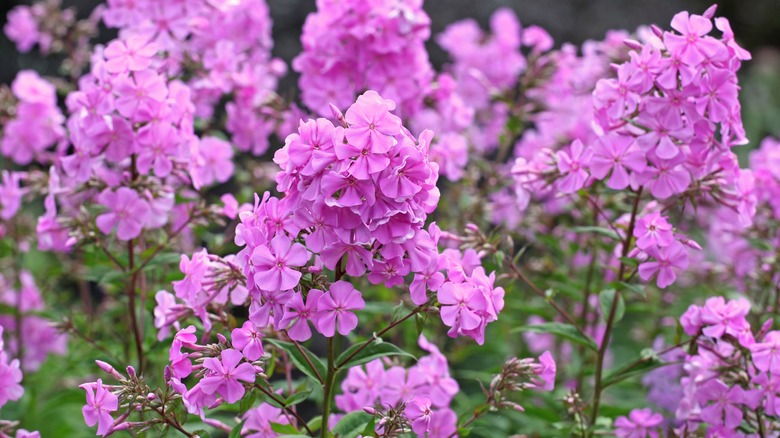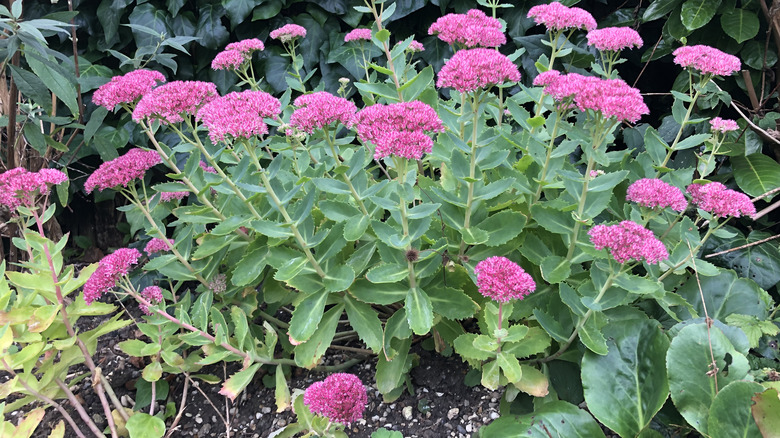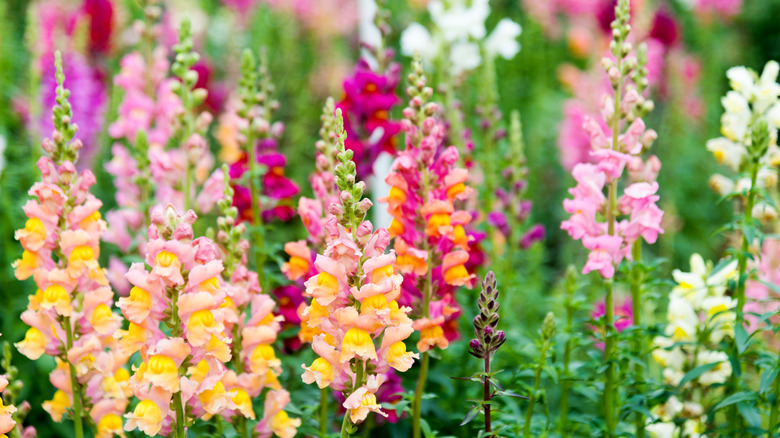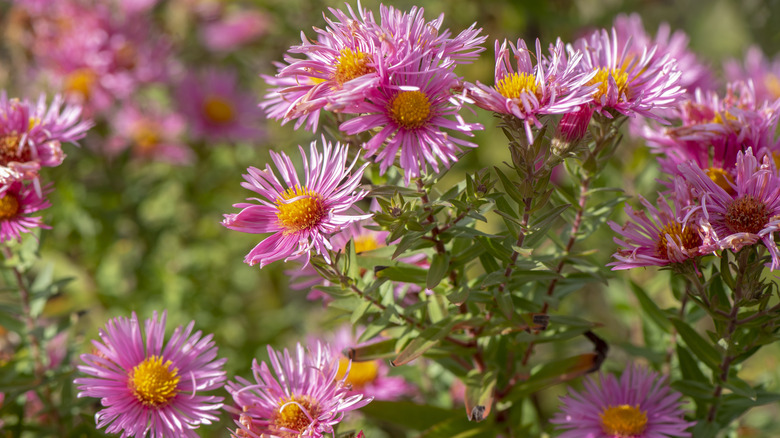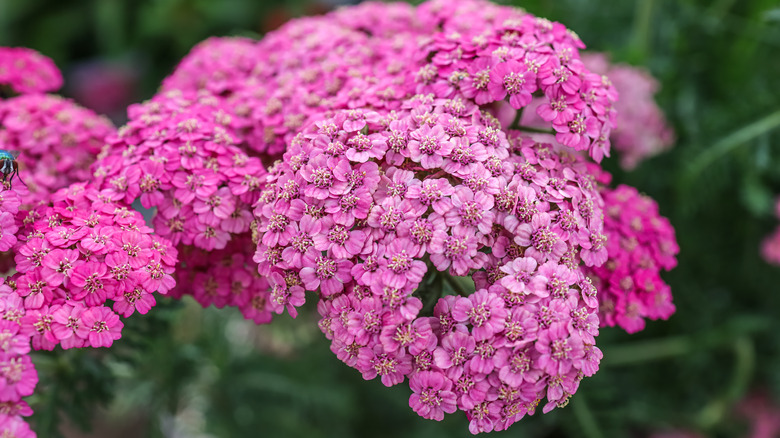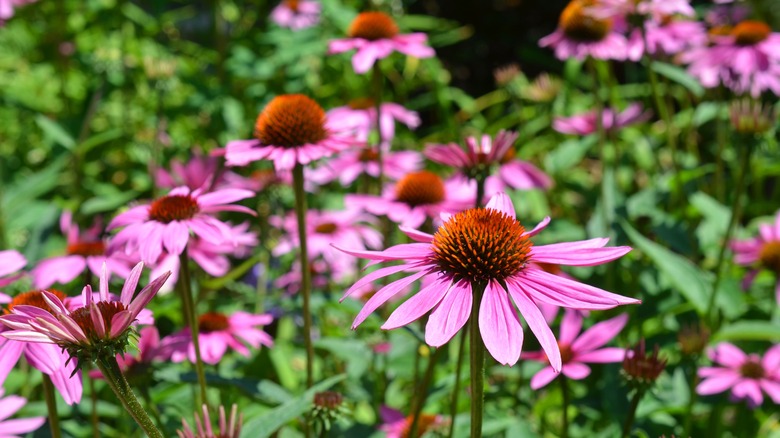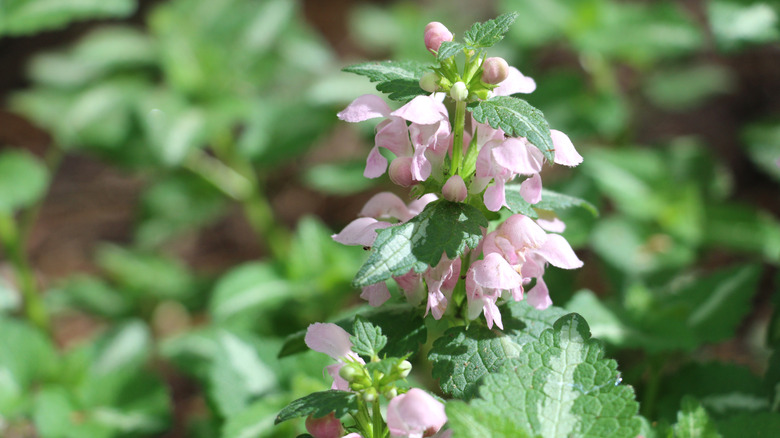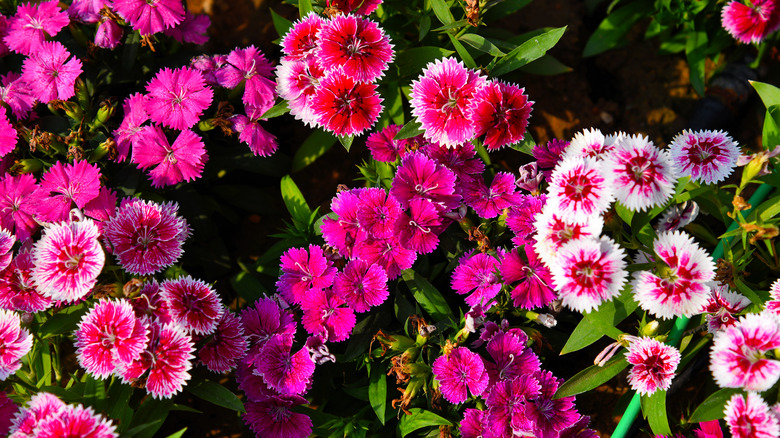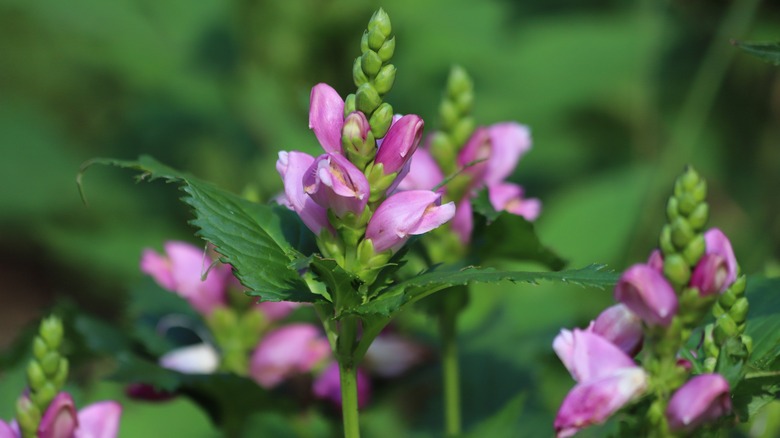12 Perennial Pink Flowers That Look Enchanting In Your Autumn Garden
As a professional gardener, I'm often called upon to design gardens that correspond to the tastes of clients, including their preferred colors. I'm not a huge fan of a design containing lots of red flowers, but if that's what the client wants, that's what they get! But if I'm given some leeway in choosing color schemes, I prefer the cooler colors, especially all shades of pink. Pink isn't just for spring and summer! This warm, inviting color brings real drama and beauty to the autumn garden, too, and perennials like mums, roses, Japanese anemones, asters, and phlox provide alluring shades of pink for the season.
Pink is one of those versatile colors with a wide range of shades, from delicate pale pinks to rich rose pinks to bold hot pinks. Fall-blooming perennials are available in virtually all shades of pink and can mix beautifully with many other colors. If you have a lot of darker colors, pink can lighten up the space. Pinks with yellow tones (like peach or coral) add warmth to your garden palette. Similarly, if you have warmer colors in your fall garden, some blue-toned pinks (like orchid, mauve, or rose) can add cool tones for visual balance.
When choosing perennials that will bloom in autumn, pay attention to their growth habits and timing to place them for maximum visual appeal. Some perennials that start blooming in summer need consistent deadheading to continue blooming into the fall season: this includes dianthus, roses, snapdragons, phlox, and yarrow. Consider also adding annuals with colorful foliage (like coleus) that last through the first frost to accent your fall season bloomers.
Japanese anemones
The nodding flowers of Japanese anemones (Eriocapitella x hybrida), sitting atop tall stems, add a delicate but dramatic beauty to the autumnal garden landscape. They come in shades of white and many pinks ranging from pastel to dark, with sunny yellow centers. 'Anemone Robustissima' is the classic pale pink single variety; also try 'Margarete' (rose pink double petals) or 'Pocahontas' (medium pink single petals). They're hardy in USDA Zones 4 to 8, thrive in some shade and full sun, and enjoy rich, well-draining soil. Just as many summer perennials produce their final blooms, Japanese anemones burst forth into flower.
Pink mums
There are many varieties of pink mums (Chrysanthemum spp.), including garden mums, cushion mums, button mums, spider mums, and others. From hot pink to pale pink, mums are long-blooming, sun-loving, sturdy perennials that lend a real burst of color to the autumn garden. Many people think of mums as annuals, but they're actually cold hardy perennials (USDA Zones 5 to 9). Try these luscious pink cultivars: 'Coquette' (candy pink with spiky petals), 'Jessica Louise' (light pink with butter yellow center petals), 'Royal Glamour' (warm rose pink), or 'Pink Crest' (rich orchid pink with yellow eye).
Roses
Many roses (Rosa spp.) bloom in early summer and again in early fall, including many David Austin roses known for producing new flushes of blooms throughout the season. Knockout roses need only consistent deadheading to bloom all summer and well into fall. Some beautiful pink David Austin roses, hardy in USDA Zones 5 to 11, include 'Silas Marner' (medium pink, double petals), 'Princess Anne' (fragrant, deep pink), and 'Scarborough Fair' (pale pink, fragrant). Reliable pink Knockout roses (hardy in Zones 4 to 9) include 'Peachy Knock Out' (light pink/peach double petals) and 'Blushing Knock Out' (single petals of pastel pink).
Garden phlox
Tall garden phlox (Phlox paniculata) bloom for weeks, often flowering through mid-autumn or beyond. Deadhead the spent blooms to keep them looking neat and encourage new flowers. There are a number of beautiful pink varieties, including 'Eva Callum' (candy pink with hot pink centers), 'Glamour Girl' (coral pink), and 'Watermelon Punch' (vivid bright pink). Phlox are hardy in Zones 4 to 8, do well in partial sun, and prefer a rich, well-draining soil. If you notice powdery mildew on the leaves, replant your phlox to give them more space and air circulation.
Sedum
Sedums (Sedum spp.) come in both upright and creeping varieties. In autumn, the upright plants come into their own with sturdy flowers that lend weeks of color to the garden, often shifting hues as the season progresses. Sedums (also known as stonecrop) are cold hardy (USDA Zones 3 to 10), drought tolerant, and bloom best in partial to full sun. Some of the prettiest pink sedum varieties include 'Neon' (bright hot pink), 'Brilliant' (rich lavender pink), and 'Autumn Joy' (pale pink shifts to dusky red).
Snapdragons
In most areas, snapdragons (Antirrhinum majus) are considered annuals, as they're hardy in Zones 7 to 11. But they often self-seed in the garden, which can make it feel like they are perennial. Some cultivars like 'Rocket' keep blooming past frost. After the flowers on the tall central stem drop off, seed heads form and the side stems start forming new buds, which I've seen keep flowering as late as early December in upstate New York. To encourage more vigorous blooms, cut the seed heads off. There are many solid and bi-color pink snapdragons to choose from.
Asters
Asters are a perennial fall favorite, with their fluffy petals and daisy-like flowers in a rainbow of cool colors. The most commonly grown are New England and New York asters, both hardy in Zones 4 to 8. They like full sun and spread nicely every year (divide in spring just after new growth emerges). The pinks range from pastel to deep fuchsia, often with cheery yellow centers, and look gorgeous alongside mums in bright autumn colors like gold and orange. Try 'Woods Pink' (low-growing, pale pink), 'Honeysong Pink' (tall, light pink), or 'Alma Potschke' (tall, hot pink).
Yarrow
With its clumps of tiny flowers forming colorful flower heads, yarrow (Achillea millefolium) is a welcome sight in the cottage garden. Hardy (Zones 3 to 9) and happy to spread gently, it starts blooming in summer. If deadheaded regularly, yarrow keeps blooming well into autumn. I've seen my yarrow, in Zone 5, continue to form new blooms well into November. Newer yarrow cultivars have exciting color variations, including pink, like 'Sassy Summer Taffy' or 'Pink Grapefruit' or the peachy-pink 'Apricot Delight.' But there are many heirloom pinks, too, like pale pink 'Appleblossom' or the soft magenta pink 'Cerise Queen.'
Echinacea
Sturdy, reliable coneflowers (Echinacea) are cold hardy (Zones 3 to 8) and produce colorful flowers with seed heads that provide food for birds and wildlife. These sun-loving perennials increase each year and flower for weeks from June through October. The newer hybrids with pompom tops (like 'Southern Belle' or 'Pink Double Delight') don't produce seeds, but with so many cultivars available, you can certainly have more than one echinacea in your garden. Other pink coneflowers include magenta pink 'Pow Wow Wild Berry,' light pink 'Pixie Meadowbrite,' or hot pink 'Fatal Attraction.'
Lamium 'Pink Pewter'
Also known as deadnettle, lamium (Lamium maculatum) is a spreading ground cover hardy in Zones 4 to 8. Though some lamium varieties can become somewhat invasive, I have found 'Pink Pewter' to be less aggressive, especially in the shady section of the garden. This variety has lovely two-tone pale green leaves and pastel pink flowers that last from summer into fall. The trailing stems can get a bit leggy in warm weather, so trim them back to keep them looking neat and fresh — these plants like a loamy, slightly acidic soil environment.
Dianthus
Commonly called "pinks," dianthus are known for their stunning range of colors. The variety known as Sweet William has round clumps of flowers on tall stems, while other varieties (D. plumarius, D. superbus, D. deltoides) are shorter. "Cheddar pinks" (D. gratianopolitanus) have spreading, needle-like foliage and, in my experience, are longer-lived than clumping Dianthus deltoides. 'Bath's Pink' is a pale pink heirloom, while 'Firewitch' is a newer hot pink hybrid with blue-green leaves. Cold hardy (Zones 4 to 8) and needing only deadheading to bloom well into fall, dianthus are a great addition to the autumn cottage garden.
Turtlehead
The turtlehead (Chelone lyonii) plant has small pink-lavender flowers that resemble turtleheads. It likes dappled shade and sun and is hardy in Zones 3a to 8b. It also likes moist soil, thriving near ponds, streams, and other damp locations. It's not very heat tolerant, so make sure to plant it in a spot that doesn't get too much late afternoon sun. The turtlehead blooms last for weeks from summer into fall and attract many pollinators to their tasty nectar.
